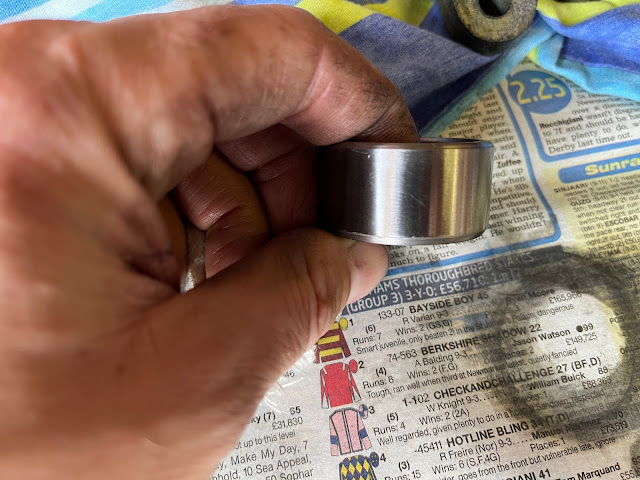She is heavy, and she ain't my brother...Ye olde Tridents were heavy. There's no way to sugarcoat it, modern bikes are an absolute joy to move around compared to the bikes of the seventies and eighties. I really feel for the older riders having to sell their old 750's and 1000's due to weight, but completely understand why they have to do it.
But it's not just the struggle onto the centre-stand, or moving it out of the garage. You sort of rely, quite heavily (oof is that a pun?), on the brakes to haul all of that extra weight up. And a fixed, two-piston caliper, on a small solid disc, needs to be in pretty good condition to do the job.
Well this bike is a 1974 model... and it is now 2022, and this is probably its first seal kit. It's done well! Not that it was leaking or anything. The pads weren't binding on the disc either, in fact, everything was pretty good. But the old seals were pulling the pistons back further than they ought to which, to the rider, means much more lever travel before retardation takes place.
She is a stunner! Completely original, bar for the Raygun silencers. If it was mine, I would've whipped out the pistons, cleaned and reassembled them with rubber grease, and it would've probably been ok. But being as I was flying back out to Oz after a couple of weeks, I thought it better to clean it all up and fit new seals as a matter of course. After all, it will never work as well as with new seals fitted.A quick phone call to the Triumph dealer had it sorted, they arrived a day later, at the same time as my BSA gearbox parts. With the bike up on the bench, we set to work. The front wheel has to be removed before you can take the caliper off due to it having studs fitted - strewth, how times have changed!
With caliper removed, you will see that there is some dirty brake fluid in there. Something I have noticed when taking calipers apart is that you can never remove everything with just a brake fluid flush. If you buy a bike secondhand, consider popping out the pistons as part of your brake service. A clean-up of the piston and calipers' internals may be all that is needed. Yes, corrosion does build up behind the seals too, but just pop out the pistons and check what you can get away with. Having seen the orange jelly that was inside the Tokico's on my Bandit, it really isn't worth the risk. But I digress, as usual...
Looking at the back of that piston, you get a real idea on how crap can build up in there. This won't come out with a brake fluid flush.
This pic gives you a better view. Mechanical components work at their best when they are perfectly clean and lubricated. From chains to brakes, crankshafts to gearboxes. There has never been a time when they benefitted from being dirty. Give your bike every benefit you can, and you will appreciate it.
As you can see, there is the main seal designed to stop any fluid coming past the piston, and then an outer dust seal to stop dirt going in. Being old school, this dust seal is metal-backed.
I would've liked to have more pics of the removal of seals, but my hands were covered in crap. The dust seals popped out much easier than I thought they would and were reusable if needed. A wide pry bar/screwdriver made it easy.
The pistons, once removed, will always have slight marks on them. Just get a rag and clean up with some WD40 or similar. Then take some 600 wet & dry and, using WD40 again, clean them up leaving a perfect matt finish all the way around. Slight pitting will actually be fine (my experience) but, if it's deep, buy new pistons.
That residue will be removed easily. The fine (600) grit wet & dry will leave a perfect finish for the new seals.
Perfect!
With new seals fitted and rubber grease applied, the pistons can be refitted. Some people will tell you not to use any grease at this stage. By all means, use brake fluid.
I, personally, have always used rubber grease and then flushed the system fully when bleeding. Brake fluid is horrible on your skin, and I avoid it where I can. In the pic below you can see the new seals with rubber grease smeared around them.
I have no more pics of the assembly, unfortunately. The pistons can be awkward to get past the dust seals but gentle perseverance is key. Don't force them. When it's right, they'll slide in.
After this, both sides of the caliper are bolted together with a new seal in between both halves. Reassembly consists of fitting back onto the fork leg, and brake pipes reattached. With the wheel and brake pads refitted, bleeding is carried out as normal.
With that, it was time for a good horsing... uh, road test. Happy to say the lever is back where it should be and the brake is pretty effective for the size and weight of the bike. It was a lot of fun riding the Trident again, the noise of that engine leaves you wanting more every time. I want that whine of the triple to get louder all the way to the redline... don't worry Dad, I won't redline it!

Thanks for reading, bikes are great, and there will be more soon.












No comments:
Post a Comment